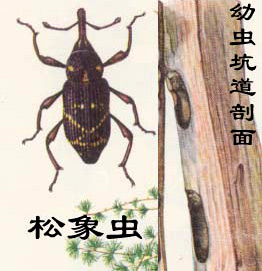This species is also called the pine bark weevil and the pine bark weevil. The adult body length is 7 to 13 mm. The body and elytra are both dark brown. The back of the chest is irregularly covered with circular engraved spots of varying sizes. The antennae are knee-like, stalked, and are attached to the front half of the beak. There are four dots made of golden phosphorus on the chest (two on each side of the midline of the back). There are nearly rectangular dotted dots arranged vertically on the elytra and an X-shaped pattern composed of golden scales. The male has 8 segments on the back of the abdomen; the female has 7 segments on the back of the abdomen.

Egg: about 1.5 mm, oval, white and yellowish, transparent. Scattered on the root bark or in the soil.
Larva: Curved, legless. When mature, the body is 10-15 mm long, with a yellowish-brown head and white body. Abdomen 9 segments. There is a pair of oval spiracles on the 1st thoracic segment and the 1st to 8th abdominal segments.
Pupa: Naked pupa, the same length as the adult, all white except for the upper jaw and compound eyes, which are black. The body is covered with symmetrically arranged spines. The abdomen is square and has a pair of large protective spines.
Living habits: Pine weevil lives in the Xiaoxing'anling forest area with one generation every two years. Overwinters in both adult and larvae states. In mid-to-late May, the overwintering adults begin to live and feed and mate on the larch regeneration ground, damaging saplings that are more than 2 years old. After mid-June, adults spread from the regeneration area to the logging area and lay eggs under the cutting roots. After late June, newly hatched larvae appear one after another and make tunnels to feed in the cortex of the cutting roots or between the cortex and sapwood. By the end of September, most of the larvae have matured and are dormant in the cortex, cortex and sapwood, or all within the sapwood, making oval-shaped pupae. A small number of larvae that hatch late are not yet mature when they overwinter and need to feed for a period of time the following spring before going into hibernation in the pupa chamber. The mature dormant larvae at the end of autumn last year pupate in July and August after the overwintering stage, and begin to emerge into adults after the end of July. After most of the new adults lurk in the pupae for about half a month, they crawl out of the soil from the roots and look for young materials to feed on. They do not mate and lay eggs that year. After the end of September, they overwinter in the litter in the rhizosphere of larch saplings; a few adults that emerge later do not emerge from the soil and overwinter in the pupa chamber. It takes two years from the egg hatching to emerging as an adult, and then the adult lays eggs again.
The damage stage of the pine weevil is as an adult (the larvae parasitize in the cut roots, and the economic losses are small); it bites the phloem of the trunk under the tips, causing massive scars and exuding a large amount of rosin. If there are many scars, when the tree is surrounded by a ring, the tips will die. For saplings damaged by pine weevil, the main trunk usually dies, and several side branches grow upward at the same time. The crown is large but not high enough, resulting in poor growth of dry wood and loss of economic value. In severe cases, the entire plant may even die.
animal tags:
We created this article in conjunction with AI technology, then made sure it was fact-checked and edited by a Animals Top editor.